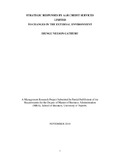| dc.description.abstract | All organizations are environment dependent. They are in constant two way interaction with the environment and depend on it for continued survival. All organizations operate as open systems. This means that they take an assortment of resources from the environment, add value and then deliver them back to the environment. According to strategic success hypothesis advanced by Ansoff and McDonnell (1990), organization's strategy and internal capability must keep changing to match the environmental conditions. Strategy is therefore not static and it keeps changing even within an organization. As a result it would no longer be possible to devise a single prescription for response to challenges which would apply to all industries and firms.
According to Pearce and Robinson (1997), in order for organizations to achieve their goals and objectives it is necessary for them to adjust to their environment. An organizations' success is dependent on its responses to changes in the environment. The environment can be classified into the internal and the external environments. The internal environment is composed of elements within the organization; these include current employees, management philosophy, managerial leadership styles, organization culture, financial resources, technology, human resources and standard operating procedures. The internal environment is within the control of the organization and is composed of controllable variables.
This study set out to address one objective which was to determine what strategic responses AAR Credit Services Limited has employed to adapt to the changes in the external environment. To achieve this objective the study made use of both primary and secondary data. Primary data was collected through personal interviews with senior management at AAR Credit Services Limited.
Secondary data was obtained from AAR Credit Services Limited's financial statement and in-house publications. A content analysis was then carried out on the data obtained to allow for in-depth understanding of issues in the case. The study found out that the company did not respond to all the changes in the environmental conditions but to those changes which were deemed to impact on the company's activities. The study identified the following factors to have initiated responses from the company. In the political environment the key variable had been the post election violence in 2008, in the legal environment the key variable had been in enactment of the micro finance Act of 2006.
In the technological environment the key variable had been lack of adequate information system and high rate of obsolescence and new technological developments. In the economic environment key variables had been low income levels and high cost of factors of production. In the socio-cultural environment, key variables had been lifestyle changes, income distribution, lobby groups. In the competitive environment the key challenges had been from new entrants in the industry and business undercutting. The study recommended that AAR Credit Services Limited should comply and get a license for taking deposits in order to lower the interest rates, improve human capital and get more equity funding to ensure low costs of operations, increased returns and specialization among the staff.
The study suggested that in order to understand the strategic responses responsible for the changes at AAR Credit Services Limited a further study could be carried out in other companies within the micro finance industry, a further study could also be carried out to determine why AAR Credit Services Limited choose to use the responses it had adopted. Further, a study could be carried out on AAR Credit Services Limited to determine how the company would alter its strategies to other changes in the environment in future. The study concluded that even for companies that were successful, it is comparative that they continuously engage in strategic responses to ensure that the organization strategies are aligned and match with external environment. | en_US |

